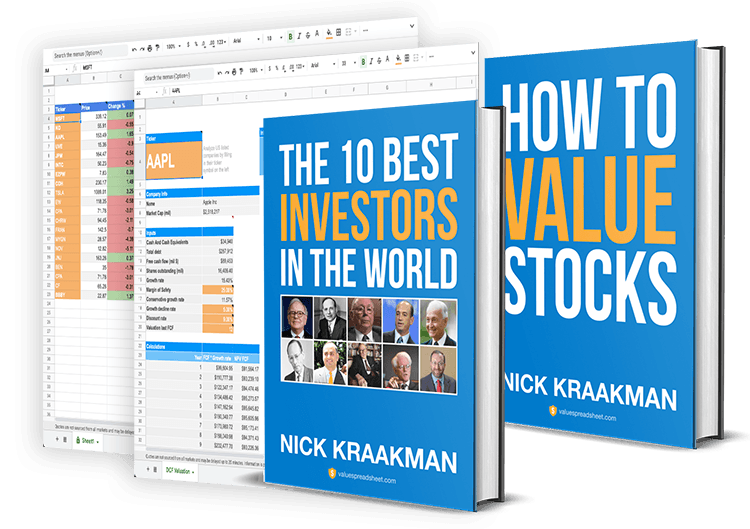
Investors generally underperform the market because they do not buy stocks that are healthy and cheap, but stocks which grab their attention.
The reason why this approach leads to sub-par returns is because stocks which are covered in the media and followed closely by the masses are less likely to be undervalued. In addition, if you invest in the stocks everyone else is investing in, your performance will be equal to theirs; average at best.
However, you can't really blame people for taking this approach, because analyzing thousands of publicly listed companies is a daunting task. Or is there an easy way to filter out the hidden gems? I would argue there is, and in this post I guide you through my simple three step process of finding healthy, undervalued stocks to invest in.
Rather listen than read? Then check out my podcast episode below.
*In the podcast I mention the Google Finance screener, which has unfortunately been discontinued.
Step 1: Generate ideas
Goal: identify +-30 companies to analyze further

Finding stocks to analyze is something many investors struggle with, but it is really not that hard. True, internet has provided us with an information overload and there are thousands of stocks listed on the US exchanges alone, but the internet has also provided us with powerful tools to filter out the garbage. Using free online stock screeners is my preferred method of finding stock ideas, because it allows you to make an independent, rational selection which is not influenced by opinions and emotions of others.
Remember: although we are looking for undervalued stocks, a cheap valuation is of no use if the financial situation of the underlying company is terrible. Therefore, the first step is to determine when you consider a stock "garbage" and when you consider it a wonderful company.
"It is far better to buy a wonderful company at a fair price than a fair company at a wonderful price."
Warren Buffett
The basic criteria I always use in this stage are:
- Return on Equity > 15%
Indicates high profitability and potentially a competitive advantage - Debt-to-Equity ratio < 0.5
Implies that the company does not heavily depend on outside capital to finance its growth - Current ratio > 2
Makes sure that the company is able to pay its short term obligations
It is tricky to filter on P/E, because P/E ratio's differ greatly per industry and thus you potentially exclude perfectly sound investment ideas. On top of that, P/E in itself does not say much about whether or not a company is undervalued with respect to its intrinsic value. For similar reasons I dislike filtering on EPS growth rate, because a solid company with 0% growth can still be an interesting buy if the price is right.
Sometimes I do add Dividend Yield > 1% as a criteria, because I like receiving a steady dividend income. Another criteria I sometimes filter on is Market Cap < 1 Billion, because smaller companies are generally less closely followed by analysts and therefore more likely to be mispriced. This theory is confirmed by Ibbotson Associates, who found that Small Cap stocks significantly outperformed Large Cap stocks over the past century.
Once you have determined your criteria, use any of the following free online stock screeners and try to end up with around 30 ideas:
Finbox
A completely free stock screener with an easy interface to filter out the good from the bad.
Yahoo Finance
Yahoo offers a comprehensive online screener for free.
FINVIZ
A popular free stock screener which I haven't used myself, but it seems to offer all the features you might need.
Alternatives
Of course using online stock screeners is merely a way to identify interesting stocks to analyze. Here are three alternative approaches you could follow:
- Use my powerful new Value Scout tool, which analyzes all stocks on the US stock market each day based on several time-tested value investing criteria, and then sorts them from highest potential to lowest potential. With Value Scout you always know what stocks to buy. Learn more...
- Check GuruFocus to see what your favorite investors are buying. GuruFucus also offers several great and unique stock screens.
- Subscribe to a paid investment newsletter, like AAII or The Motley Fool. However, do not blindly trust what others recommend and always perform your own due diligence.
Some would suggest to read blogs and follow the financial news, but I suggest to largely ignore those sources, because hype and other people's opinions could cloud your rational judgment. If you use other creative methods to come up with stock ideas, please share your experiences with the rest in the comment section so we can all learn from it.
Step 2: Create a shortlist
Goal: reduce your 30 ideas to 3 (or less) wonderful companies

Got your 30 ideas? Great! This means you have already filtered out most of the garbage. Now it is time to see which, if any, of these 30 stocks has the makings of an outperformer. In step one you ran a simple screening process, now you will have to dig a bit deeper to identify the true gems. By analyzing the Letters to Berkshire Shareholders we learn that superinvestor Warren Buffett looks for the following things in a winner stock:
- Consistently high profitability
High and preferably increasing net margins are a great sign which indicate that a company is either becoming more efficient, or is able to increase its prices. This in turn should lead to a steadily increasing book value. Also, be sure to check whether the company is generating healthy levels of Free Cash Flow (FCF). If a company reports net profit but is unable to generate FCF, this could indicate earnings manipulation. - Low debt levels
Large amounts of debt pose a significant interest rate risk and lead to inflated ROE figures. Debt heavy companies get in trouble more easily when sales slow down or interest rates start to fluctuate. A long-term debt-to-equity ratio below 0.5 is preferable, as well as a current ratio above 2. - A sustainable competitive advantage
Here the analysis goes beyond numbers and financial ratios. Highly profitable businesses attract competitors, and increased competition generally leads to lower profits, except when a company possesses a sustainable competitive advantage. Something which cannot be easily copied. Examples include patents, trademarks, lock-in effects, economies of scale, and network effects. Look for these important signs. - Honest, competent, shareholder friendly management
Stock market genius Peter Lynch suggests to look for businesses any idiot can run, because sooner or later an idiot will run it. Nevertheless, solid management plays a key role in business success. Therefore, always Google the names of the key executives to find out who they are and what their track record is. Add "scandal", "fraud", and similar words to your search to find out if they have been involved in anything shady. Do the same for the company itself. Also analyze the capital allocation strategy of the company. Use the following rule of thumb: a company with a consistently high return on equity and plenty of growth potential should reinvest (a big part of) its earnings into the company, else shareholders are better off if the company pays out a dividend and/or buys back shares. However, buying back shares should only be done when the stock trades significantly below the company's intrinsic value. - A business you understand
Buffett once said he and his business partner Charlie Munger stick to businesses they understand, and I suggest you do the same. Are complex companies less likely to outperform the market? Not per definition. However, the reason to avoid them is because the more complex a business is, the harder it becomes to make a reasonable projection about future performance. So stick to consistent performers with a business model you understand. In other words, avoid bank stocks like the plague.
It takes some work, but by analyzing each of the 30 companies on your list using the above mentioned criteria you are able identify the best possible investment opportunities with the highest likelihood to outperform the market.
Step 3: Estimate intrinsic values
Goal: find out if any of the opportunities you identified are currently undervalued

Now that you have a handful of wonderful companies left, it is time for the final exciting step: checking if the price is right to buy!
A right stock price is a price which gives you a wide margin of safety, so that you have minimal downside risk even if the future performance of the company is not entirely as expected. For example, only consider buying when the current stock price is 25% - 50% lower than the intrinsic value of the stock. This way, much of the downside risk is negated because the stock is already very cheap, while simultaneously increasing the odds of generating serious returns. Mohnish Pabrai describes this low-risk, high reward strategy as: "heads you win, tails you only lose a little." A low purchase price is absolutely crucial if you want your dream of market beating returns to come true.
There are several ways to calculate the intrinsic value of a company, like:
- Price-Earnings multiple
This method calculates a 5 year price target based on a reasonable, historical P/E valuation and then arrives at an intrinsic value estimate by taking the NPV. - Discounted Cash Flow (DCF) model
A powerful intrinsic value calculation based on the discounted value of the cash that can be taken out of a business during its remaining life. - Return on Equity valuation
The third and final method that I explain in the eBook uses one of Warren Buffett's favorite metrics of profitability: Return on Equity (ROE).
Of course I could explain all three of these models here in detail, but I have already written a free 19-page eBook called How to Value Stocks on this exact subject!
Use the above mentioned valuation models to estimate a company's intrinsic value. The very last step is then to compare this value you calculated with the price the stock is currently trading at. Is the price way below your estimate of the intrinsic value? Congratulations, you just struck gold! Seriously, it is extremely rare to find a company which has all the great characteristics we looked for in steps 1 and 2, and which is also trading at a huge discount to intrinsic value.
At this point, double check your analysis and re-run the numbers. If you are certain you have found a wonderful company which is severely undervalued, load up BIG TIME! Again, you are lucky if you find a handful of opportunities like this in a year. If you find more than that, either the stock market just crashed or your filtering criteria are not strict enough.
If the price is not right at this particular moment, add these stocks to your watch list nonetheless so you are there when the opportunity presents itself to load up at an attractive price.
Final words
Well, you just read the longest blog post I have ever written. I hope you learned a thing or two from it. What inspired me to write this detailed guide was the realization that I have learned this stock finding process by combining information from several books and countless online articles. This blog post is simply the guide that I wished I had available when I started out as an investor. If you found this guide useful, please share it freely across the interwebz and earn my eternal gratitude!
I've been studying the investment strategies of the best investors in the world for years, and have combined all this knowledge into one overcomplete training program. If you want to learn how to invest like the pros, check out my Value Investing Bootcamp video course here.




